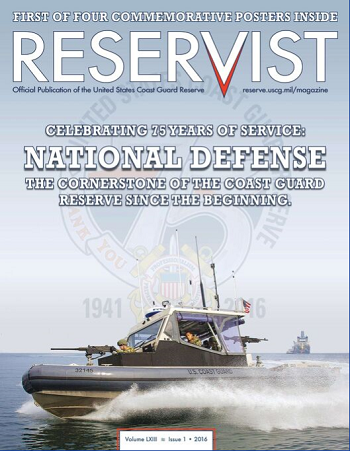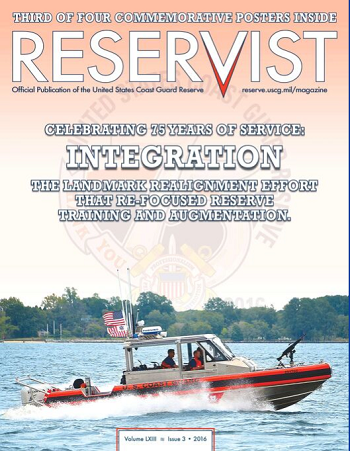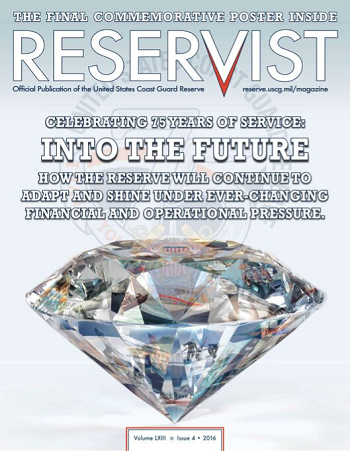
From the Editor - With my pending retirement in April, my time as Editor of the RESERVIST is drawing to a close. Depending on how the hiring process goes this could very well be my last column. So, with that in mind I would like to share the philosophy which has guided me during my tenure. I will attempt to do so by sharing an experience more than twenty years in the making.
Upon assuming the duties of editor my first priority was to ‘do no harm.’ There is a certain joy and satisfaction to be found in the responsibility of constructive stewardship. The Coast Guard, more specifically Chief Boatswain Mate Tom Branco, taught me to always leave things better than I found them. By embracing this simple wisdom, I’d like to think I have enjoyed some success in this regard.
A number of years ago I was fortunate enough to have a neighbor lady, Miss Charlotte Kent, bequeath me an old rowing dory she owned. The dory had been sitting in her boat house unattended for many, many years. Miss Kent, then in her eighties, and her sister had used the dory as young girls growing up at Kent's Point on The River in Orleans, Massachusetts.
Having spent countless days roaming the point and on The River as a child, it was really special to be entrusted with this piece of local history. According to Miss Kent, the dory was built by a local man in the early 1900s. It has a keel and ribs of oak with white cedar planking...lots of both can be found on Cape Cod.
My brother Jim and I tried to refit the dory but she needed more than we could offer. We found a local Boatwright who got her fit for the water. That was some twenty years ago. Then life happened and the dory, now rightly known as the MISS KENT, was stored away...out of sight, but not out of mind.
Last summer I met another Boatwright, Penn Colbert. Penn represents what has always been so unique and endearing about the Cape. After a brief conversation he agreed to take a look at the MISS KENT. Sometime later I got the two of them together and it was love at first sight. Penn spent the winter of 2015-16 ever so lovingly bringing the dory back to her glory days. I am very grateful for the care he has taken to get her ship shape.
My dream has always been to have her back where she belongs, on The River, where she, and I, can help a child experience the simple wonder of rowing a small but majestic vessel in one of the most beautiful places on Earth. Thanks to Penn that dream has become a reality.
And, like the MISS KENT, hopefully the RESERVIST is, in some small way, better for my time as its helm. Ultimately that is for you, the reader, to determine. What I can say is that it has been a privilege to play a small part in the magazine’s long and impressive history. There are not many publications which can say they have published continually for 64 years.
To my relief I offer my sincerest best wishes for continued success and share Chief Branco’s simple advice: always strive to be a good steward of what you have been entrusted.
As always, thanks for reading.
Click cover image to download a printable pdf

From the Editor - This issue of the RESERVIST continues our year-long focus on the Coast Guard Reserve’s 75th Anniversary spotlighting how the Reserve Component adapted from a primarily national defense posture to playing an integral role in the Coast Guard’s contingency response capability.
In Part II of her 75th Anniversary series, CWO Anastasia Devlin outlines how the component, created in response to the domestic port security demands of the Second World War, transitioned into a vital domestic contingency response capability. CWO Devlin looks at how the 1972 change to Title 14 of U. S. Code authorized augmentation of the active duty Coast Guard for response to natural or man-made disasters. The first use of this authority took place the following year to assist with flooding in the Midwest: a utilization that continues today. Over the next four decades Reserve personnel, both individually and collectively, have adapted to support contingency and surge operations from the Caribbean (Mariel Boat Lift) to Valdez, Alaska (EXXON VALDEZ) and from the Persian Gulf to the Gulf Coast. Today, the Coast Guard Reserve remains as adaptable and ambidextrous as ever. As real world circumstances dictate, reservists shift seamlessly between humanitarian and environmental response providing national defense at home and overseas.
In our Shipmates In Focus section, you will read about what lighthouse duty was like for a former reservist during the 50s and 60s. Ed Picullel shares his memories and his poem about service is a simpler time. You will also find a story about off-duty heroism which recounts how YN1 Tom Yarbrough was truly Semper Paratus.
For a heart-warming story about the human spirit and sacrifice be sure to check out the Retiree SITREP section and read how the spouse of a Reserve retiree saved the life of another retiree living 3,000 miles away.
As always, thanks for reading.
Click cover image to download a printable pdf
From the Editor - It has been my long held belief that you can observe and learn many life lessons from the world of sports. I am not talking about the world of professional sports, though lessons abound there as well, but rather about the hundreds of thousands of amateur sports venues around the country from Pop Warner Football to Little League Baseball. One of these lessons occurred one summer when one of my sons was playing Little League ball. It was then, I think, that I first began to internalize the difference between being part of a team rather than just being on a team.
though lessons abound there as well, but rather about the hundreds of thousands of amateur sports venues around the country from Pop Warner Football to Little League Baseball. One of these lessons occurred one summer when one of my sons was playing Little League ball. It was then, I think, that I first began to internalize the difference between being part of a team rather than just being on a team.
The back story may sound familiar. League rules require that all kids play at least two innings per seven-inning game. Our team was pretty competitive and made a four team post-season playoff. During the season the coaching staff played by the rules, but played to win. The “better” players usually played the first 5 innings with the bench players getting plugged in to meet the league minimum playing time rule; generally at the end when the outcome was pretty much decided.
We made it to the semi-finals. It was a very close game as it entered the final two innings. The other team had been changing players out earlier in the game, but we had not. With the game on the line, the coach went to the bench players so as not to be in violation of the rules. In the end we lost and the coach was terribly upset with the play of the substitutes. Muttering to us parents something to the effect of, “Did you see the way they played? Didn’t they realize how important this was?” It was pretty clear to me he didn’t get the concept of being part of a team versus just being on a team. Had he chosen to make those players an integral part of the team from the beginning perhaps, just perhaps, things would have gone differently.
With In this issue of the magazine you will read about the efforts – past and present – that the Coast Guard has made and continues to make to ensure Reserve personnel are not just on the team but a valued and contributing part of the team. Because in the end, all most folks want is what those Little Leaguers wanted: a chance to step up to the plate and make a solid contribution whenever and wherever they can. Leaders are responsible for ensuring they are ready.
As always, thanks for reading.
Clic cover image to download a printable pdf

From the Editor - The great American philosopher and not half bad professional baseball player Yogi Berra once observed, “You’ve got to be very careful about where you are going, because you might not get there.” We agree.
We wrap up our year-long coverage of the Coast Guard Reserve’s 75th Anniversary with a peek into the future as seen through the eyes of the component’s senior leaders: Rear Admirals Kurt Hinrichs, Francis “Stash” Pelkowski, Scott McKinley and Coast Guard Reserve Force Master Chief Eric Johnson. Their collective vision identifies both the challenges and opportunities which lie ahead as the Coast Guard and its Reserve force adapt to the ever-changing world of resources and threats.
Beginning with our interview with Adm. Paul Zukunft in Issue 1, 2016, we have attempted to highlight the importance and relevance of the men and women who constitute the Coast Guard Reserve: both today and since its formation during the dark days of the Second World War. Stealing shamelessly from our anniversary theme, we owe a special “Thank You” to reservist CWO Anastasia Devlin who has so eloquently captured the story of the Reserve since its inception on February 19, 1941, through present day and with an eye to the future.
Speaking of the future, Public Affairs Specialist Chief Petty Officer Susan Blake’s feature article about Sector Mobile’s implementation of the Boat Forces Reserve Management Plan highlights how many units are moving themselves and the service forward. And, Public Affairs Specialist Second Class Emaia Rise takes a look at Sector Field Office Atlantic City’s initiative to improve the training and readiness of reservists assigned to engineering support billets.
Looking ahead to 2017, we will strive to keep Yogi’s words front and center as we continue to seek out and publish articles which give our readers both a sense of where we are today and where we are headed in the future.
As always, thanks for reading.
Click cover image to download a printable pdf